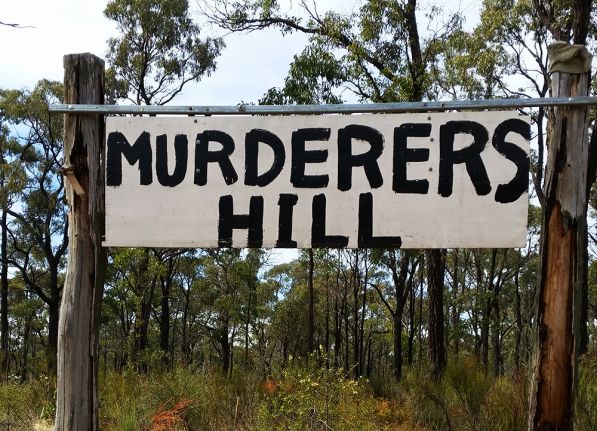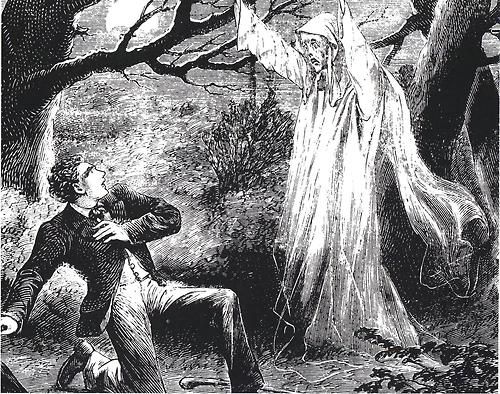 Young man holding smoking shotgun at the throat of his uncle, who lay in his bed beside his wife. Richard Egan Lee, April 12 1876, Melbourne. Source: State Library Victoria.
Young man holding smoking shotgun at the throat of his uncle, who lay in his bed beside his wife. Richard Egan Lee, April 12 1876, Melbourne. Source: State Library Victoria.
The Victorian Goldfields host a rich, fascinating, and often gruesome history.
A casual browse through old newspaper articles can quickly reveal the darker side of life in Victoria during the 19th and early 20th centuries.
The following list will take you on a tour of some of the region's grim history, including murders, suicides, horrific assaults, disaster, tragedy, lone/notable graves, gaols, asylums and ghosts.
Life during the gold rush
Murder, suicide and assault
Mia Mia Flat, a historic goldfield between Talbot and Lillicur, harbours a dark and terrible history. At least two murders occurred on these diggings in the mid 1800's as well as a horrific attempted axe murder.
Read more...
Ellen Randell was travelling home from Maryborough by buggy with her fiance, Robert Bowring, when she stopped to pick wattle flowers beside the road. Bowring shot her in the head, then traveled a little further along the track before stopping to shoot himself.
Read more...
Treacherous roads, risk of getting lost, assault and robbery by bushrangers... travelers to the goldfields of Victoria during the 1850's had every reason to fear the journey through the dreaded Black Forest!
Read more...
A grievous tale told by Ellen Clacy in her book
A Lady's Visit to the Gold Diggings of Australia in 1852-53 describes the tragic demise of a woman who, set to marry her love on Christmas Day, was abandoned at the altar and left in disgrace. The short story tells of the woman's Christmas wedding betrayal, her subsequent fall into depression, her realization that she was pregnant, the death of her newborn child, and her own death shortly thereafter; all with the dramatic flair that stories tend to pick up as they are passed along from one person to another and another.
Read more...
In 1855 on the Alma goldfields, there was a dispute over ownership of a claim between a digger named John M'Crae and a group of Tipperary men. The dispute over the claim ended with "the Tips" attacking M'Crae with picks and clubs, who retaliated with a shot of his revolver, wounding one of his attackers in the face. What followed this incident was a grand movement, a general rising of the diggers in their thousands - not for war, but for justice.
Read more...
Murder, massacre and mishap - this pioneers memorial grave in Mount Alexander Shire has quite a gruesome history. This memorial was erected in 1949 to commemorate the burial site of three people associated with the Glengower station who died in the early 1840s. The first man buried here, a cook at Glengower station, was murdered and a terrible massacre followed in retaliation to his death. The second man was savaged to death by dogs, and the third was an employee who died of natural causes. Read more...
The Clunes Cemetery is the site of a 1920's suicide of an almost theatrical nature. Matthew Birch, sexton at the Clunes Cemetery, was found dead in the yard of the cemetery lodge by his wife early one morning, his head completely blown off. Cause of death was determined to be a deliberate, self inflicted explosion of dynamite. Birch had wrapped a coat around his head before causing the explosion. Pieces of
the head and brains were reportedly spattered about the trees and on a fence. Read more...
Murderer's Hill is near the site of a double murder between Dunolly and Jones' Creek in 1857. The spot close to where this murder took place was named Murderer's Hill and the name has endured to this day.
Read more...

DISASTER AND TRAGEDY
Gallant rescue of six miners by John Hodge, Sen. Captain of the shift, New Australasian No. 2 mine disaster. David Syme and Co. December 23, 1882. Source: State Library Victoria.
The New Australasian No. 2 Deep Lead Gold Mine in Creswick was the scene of one of Australia's worst underground mining disasters. On the 11th of December 1882 forty one men entered the New Australasian No 2 mine to work a seemingly ordinary Monday night shift. In the early hours of Tuesday morning, 12th of December 1882, water flooded the mine from the old workings of Australasian No. 1 trapping twenty seven of the men underground. Rescue efforts commenced immediately but by the time the miners were reached three days later only five had survived. The body of one man was still warm when it was recovered.
Read more...
The following collection of incidents were printed in newspapers across Australia during the 1850s, and tell of tragic accidents where miners were literally buried alive. Some miraculously escaped with their lives, others were killed on the spot, and some clung to life for hours before succumbing to their injuries. In some cases trapped miners were alive when rescue efforts commenced but tragically perished before rescuers could reach them. A riveting first-hand recollection of a Ballaarat (now Ballarat) miner describes many local mining accidents - including several miraculous escapes. We will begin with a few stories of survival against the odds before turning to tragic deaths, an apparent attempt to cover up a murder using the all-too-common mining accident as a ruse, and finally the fascinating recollections of the Ballaarat miner.
Read more...
Life for children on the goldfields during the 1850's gold rush was rife with danger and illness - the
Pennyweight Flat Children's Cemetery in Castlemaine is a heartbreaking testament to the fact. An attentive stroll through any large gold rush cemetery will reveal many graves of children who tragically met early ends on the goldfields due to injury or illness.
Read more...
Take a short stroll through the Hustlers Reef Gold Mining Reserve and learn about the history of one of Bendigo's richest underground mines - and the site of the town's worst mining accident. Detailed information signs along the walking track present the operations and successes of the The Great Extended Hustlers Mine, along with the 1914 disaster which saw seven miners killed in an explosion 321 metres below the surface.
Read more...
This impressive stone obelisk was the first monument erected in Victoria to commemorate the achievements of Burke and Wills, the famed adventurers who tragically lost their lives returning from their famed expedition across the Australian continent.
Read more...Lone graves, notable graves, and cemeteries of the Victorian Goldfields
Many people have heard of the Walhalla Cemetery's famous cursed grave in Gippsland VIC, which bears an inscription foretelling the doom of all those who stand over the tomb. Did you know that there is a grave in Timor, 10 minutes from Maryborough, which bears the very same curse? Both men died in mining accidents in the late 19th century, both graves display the same grim poem.
Read more...
The intriguing lone grave of a mother and her infant son is hidden away in a lane between Chapel Street South and Fountain Track in Maldon, Victoria.
Read more...
A lone unmarked grave, thought to be the resting place of the first child to die in this area in the 1850s, sits about 50 metres off Watersons Road just outside Maldon.
Read more...
The lone grave of Katherine Patterson and Mary Lumsden Patterson sits beneath a tree in a grassy field alongside Lake Eppalock, just down the road from the beautiful
Moorabbee Bluff.
Read more...
Located at the Avoca Lead Wayside Stop, the tomb of Bi Jiang (dated 1850s) was found on this site and is now presented within a small fence and clear cover. It sits alongside the site of the butcher shop run by Bi Jiang (English name Percy Kang Senior).
Read more...
The grave of Catherine Glen Rinder can be found along Wilson Street in Wedderburn, Victoria. This was an early burial site which was never gazetted. Although there is evidence of other burials, Catherine's grave is the only immediately visible grave at this site.
Read more...
Thomas Whyte's lone grave lies in the bush alongside Bernarra Street in Wedderburn. Whyte was a miner during the 1850s gold rush and his tent was located close to the grave site.
Read more...Little Doaty's grave sits right alongside the Blackwood Cemetery's entrance gate and is adorned with colourful decorations. This is the grave of four year old Josephine Rowan, who died of diphtheria in 1878 - an all-too-common fate for
children of the gold rush.
Read more...
The lone grave of Elizabeth and Fanny Escott sits alongside Evanmore Track in Chewton. After the death of her husband, Elizabeth Escott and seven of her eleven children emigrated to the goldfields from England in 1853. Within two years, two of her daughters had died, and Elizabeth herself died a year later.
Read more...
The story of Ninnes Grave is a heart breaking and all-too-common tale from the early years of Victoria's gold rush. After a difficult ten week journey from the copper mines of South Australia to the gold diggings of Victoria, tragedy struck the Ninnes family when Thomas Ninnes' wife, Maria and two young daughters, Grace and Jane died, leaving Thomas and their two surviving daughters, Martha and Mary, to grieve their untimely demise. Thomas built their coffins, dug the grave, carved their names in a tree and constructed a small stone fence around their burial site.
Read more...
The Pennyweight Flat Children's Cemetery in Moonlight Flat is a heartbreaking result of the awful living conditions in the diggings during the gold rush of the 1850s. Around 200 shallow graves, most marked only by small stone rings and piles, are scattered amongst the trees.
Read more...
Along with the 19th century gold rush came the inevitable establishment of many cemeteries throughout the Victorian Goldfields. A wander through a historic cemetery within the goldfields can be quite captivating and educational. Some cemeteries are still in use today, others have been long abandoned.
Read more...
BUSHRANGERS
An 1855 cartoon of a bushranger robbing a traveller in Victoria's Black Forest. Image source, State Library Victoria.
June 1922 - Ernest Clifford Hull was just 17 years old when he held up the Clunes Knitting Mill, getting away with about 85 pounds. He had recently been put out of a job at the mill after a dispute with one of the men. After the robbery he headed off to a hideout near Talbot which he had prepared and stocked with supplies. Along the way he encountered a wood-carter and paid him to take a note to the Mayor of Clunes, with the intention of making the public believe he had gone bushranging - he intended to return to the knitting mill as he knew the mill's pay day and the rough time the money would be out on the table.
Read more...
Melville Caves is a popular picnic/camping destination near Inglewood, partly because of its scenic natural beauty but also because of its associations with one of the state's most picturesque and mysterious bushrangers, Captain Melville. It is reputed that the caves were used by Melville as his headquarters when he preyed on the gold escorts of the 1850s. Read more...
GAOLS AND ASYLUMS
Now a museum and tour complex, J Ward started out as a goldfields prison in the year 1861. When the gold rush faded in the 1880's, the buildings were transferred to the Ararat Lunatic Asylum and the gaol was converted into a ward for the criminally insane. Some of the most dangerous and deranged men in the state were housed here in horrific conditions.
Read more...
Christened "The Logs" by then Carisbrook resident Tilly Aston, this was the major gaol in the extensive Carisbrook Police District until 1858, and it remained Carisbrook's gaol for low key offenders until about 1900. Several notorious bushrangers were imprisoned at "The Logs": these included Morgan the Murderer, and reportedly Frank McCallum and Captain Melville. Suspected murderer John Sweeney had to be removed here for fear he would be hanged by the mob. It is likely that Joseph Brooks, who killed Constable Barnett at Havelock in 1858, and his three accomplices were also gaoled here initially.
Read more...
The Old Castlemaine Gaol sits atop a hill overlooking the beautiful gold rush town of Castlemaine. Constructed between 1857 and 1864 using locally quarried sandstone and Harcourt granite, the gaol is a striking testament to the town's pre-eminece during the Victorian gold rush. The gaol was built to house offenders from the goldfields and surrounding areas, and ten prisoners were executed by hanging within its walls during the second half of the 19th century. Over the years, the stone complex served as a goldfields gaol, a reformatory school for boys, then a medium security prison before finally closing in 1990.
Read more...
A beautiful feature on the corner of Market and Bull Streets in Dunolly, this heritage precinct includes a 1958 police station, and an older 1863 lock up and police stables. These buildings were beautifully restored in 2014, and small plaques on each of them provide some historical information.
Read more...Ghosts and paranormal activity
A ghost frightens a man, from The Illustrated Police News.
A ghostly figure terrorised the town of Maryborough, Victoria in 1871, appearing near Princes Park, Blackman's Lead and the reservoir. The figure was dressed in ghastly white and reportedly stood for hours transfixed in one spot, hastily receding when approached.
Read more...
Ghost tours are a great way to learn about the sometimes gruesome history of our region. Various ghost tours differ so greatly from each other that you cannot simply stop at one! You can learn about the terrifying conditions at the Aradale Lunatic Asylum, take a guided stroll through Ballarat's Old Cemetery and the town's forgotten underground, walk the halls of 1800's gaols and learn about some of the particularly terrible inmates and incidents, or become a paranormal investigator for the evening using state of the art technology and techniques. Experience tours run by historians, paranormal investigators, mediums, and theatrical performers - every tour is unique.
Read more...










